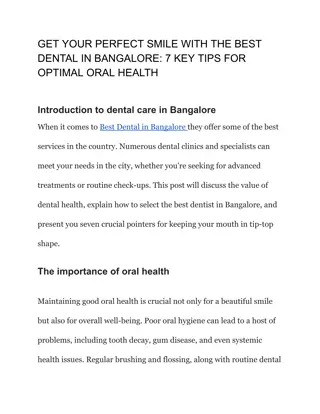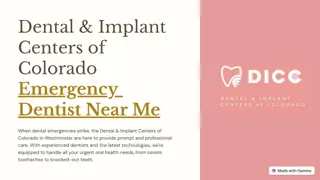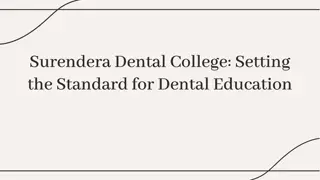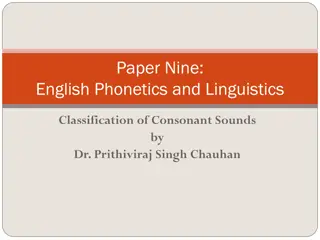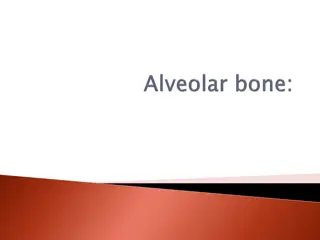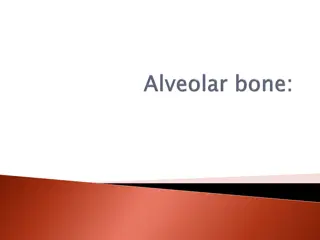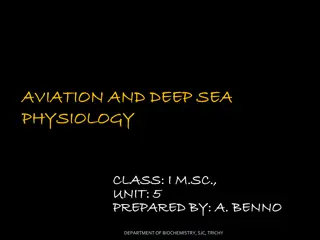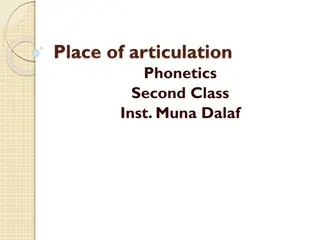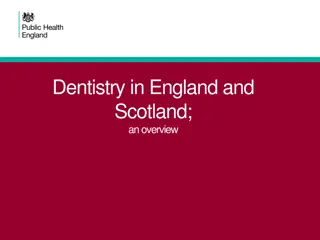Understanding the Role of Alveolar Process in Dental Development
The alveolar process in the upper and lower jaw plays a vital role in housing, supporting, and protecting teeth. It anchors tooth roots, facilitates tooth movement for proper occlusion, absorbs and distributes occlusal forces, supplies vessels to the periodontal ligament, and aids in tooth eruption. The development of tooth germs within the alveolar bone compartments is intricately linked to bone remodeling processes. As teeth erupt, the alveolar process grows in height and differentiates into structures essential for tooth support.
Download Presentation

Please find below an Image/Link to download the presentation.
The content on the website is provided AS IS for your information and personal use only. It may not be sold, licensed, or shared on other websites without obtaining consent from the author. Download presentation by click this link. If you encounter any issues during the download, it is possible that the publisher has removed the file from their server.
E N D
Presentation Transcript
Is that part of upper/lower jaw that responsible for carrying the teeth and support them. In addition to provide the attachment of some muscles of the face and mastication.
1- Houses the roots of teeth:Anchors the roots of teeth to the alveoli, which is achieved by the insertion of Sharpey s fibers into the alveolar bone proper 2-Helps to move the teeth for better occlusion. 3-Helps to absorb and distribute occlusal forces generated during tooth contact. 4-Supplies vessels to periodontal ligament. 5- Houses and protects developing permanent teeth, while supporting primary teeth. 6-Organizes eruption of primary and permanent teeth.
Near the end of the second month of fetal life, the maxilla as well as the mandible form a groove that is open towards the surface of the oral cavity. Tooth germs develop within the bony structures at late bell stage. Bony septa and bony bridge begin to form and separate the individual tooth germs from one another, keeping individual tooth germs in clearly outlined bony compartments.
Tooth germ movement occurs by bone remodeling of bony compartment through bone resorption and bone deposition. The major changes in the alveolar process begin to occur with development of roots and tooth eruption. As roots develop, the alveolar process increases in height. Also, the cells in the dental follicle start to differentiate into periodontal ligament and cementum.
At the same time, some cells in the dental follicle differentiate into osteoblasts and form alveolar bone proper. Hence, an alveolar process develops only during the eruption of the teeth It is important to realize that, during growth, part of the alveolar process is gradually incorporated into the maxillary or mandibular body while it grows at a fairly rapid rate at its free borders. The alveolar process gradually diminishes in height after the loss of teeth.
Two parts of the alveolar process can be distinguished, the alveolar bone proper and the supporting alveolar bone. a a- -Alveolar bone proper The alveolar bone proper consists partly of lamellated and partly of bundle bone. It surrounds the root of the tooth and gives attachment to principal fibers of the periodontal ligament. Alveolar bone proper
The lamellar bone contains osteons each of which has a blood vessel in a haversian canal. Blood vessel is surrounded by concentric lamellae to form osteon. Some lamellae of the lamellated bone are arranged roughly parallel to the surface of the adjacent marrow spaces, whereas others form haversian systems.
Bundle bone is that bone in which the principal fibers of the periodontal ligament are anchored. The term bundle was chosen, because, the bundles of the principal fibers continue into the bone as Sharpey s fibers. The bundle bone is characterized by the scarcity of the fibrils in the intercellular substance. These fibrils, more over, are all arranged at right angles to Sharpey s fibers. Bundle bone is formed in areas of recent bone apposition.
Radiographically, it is also referred to as the lamina dura which is due to the presence of thick bone without trabeculations, that X-rays must penetrate and not to any increased mineral content. The alveolar bone proper, which forms the inner wall of the socket is perforated by many openings that carry branches of the interalveolar nerves and blood vessels into the periodontal ligament, and it is therefore called the cribriform plate lamina dura, because, of increased radiopacity, cribriform plate .
Bone between the teeth is called interdental septum cribriform plate. interdental and interradicular septa contain the perforating canals of Zuckerkandl and Hirschfeld (nutrient canals) which house the interdental and interradicular arteries, veins, lymph vessels and nerves. interdental septum and is composed entirely of
(a) Cortical plates (b) Spongy bone a a- -Cortical plates Cortical plates consist of compact bone and form the outer and inner plates of the alveolar processes. The cortical plates, continuous with the compact layers of the maxillary and mandibular body, are generally much thinner in the maxilla, than in the mandible. They are thickest in the premolar and molar region of the lower jaw, especially on the buccal side. In the maxilla, the outer cortical plate is perforated by many small openings through which blood and lymph vessels pass. In the region of the anterior teeth of both jaws, the supporting bone usually is very thin. Cortical plates
No spongy bone is found here, and the cortical plate is fused with the alveolar bone proper. Both cribriform plate and cortical plate are compact bone separated by spongy bone. Histologically, the cortical plates consist of longitudinal lamellae and haversian systems .In the lower jaw, circumferential or basic lamellae reach from the body of the mandible into the cortical plates.
Spongy bone fills the area between the cortical plates and the alveolar bone proper. It contains trabeculae of lamellar bone. These are surrounded by marrow that is rich in adipocytes and pluripotent mesenchymal cells. The trabeculae contain osteocytes in the interior and osteoblasts or osteoclasts on the surface. These trabeculae of the spongy bone buttress the functional forces to which alveolar bone proper is exposed. The cancellous component in maxilla is more than in the mandible.
Type I the interdental and interradicular trabeculae are regular and horizontal in a ladder like arrangement. The architecture of type I is seen most often in the mandible and fits well into the general idea of a trajectory pattern of spongy bone. Type II shows irregularly arranged, numerous, delicate interdental and interradicular trabeculae. Type II, although evidently functionally satisfactory, lacks a distinct trajectory pattern, which seems to be compensated for
by the greater number of trabeculae in any given area This arrangement is more common in the maxilla. Both types show a variation in thickness of trabeculae and size of marrow spaces.
Mesial drift and continuous tooth eruption elicit remodeling of alveolar bone proper. During the mesial drift of a tooth, bone is apposed on the distal and resorbed on the mesial alveolar wall . The distal wall is made up almost entirely of bundle bone. However, the osteoclasts in the adjacent marrow spaces remove part of the bundle bone, when it reaches a certain thickness.
In its place, lamellated bone is deposited. On the mesial alveolar wall of a drifting tooth, the sign of active resorption is the presence of Howship s lacunae containing osteoclasts. Bundle bone, however, on this side is always present in some areas but forms merely a thin layer.
This is because the mesial drift of a tooth does not occur simply as a bodily movement. Thus resorption does not involve the entire mesial surface of the alveolus at one and the same time
Moreover, periods of resorption alternate with periods of rest and repair. It is during these periods of repair that bundle bone is formed, and detached periodontal fibers are again secured. Islands of bundle bone are separated from the lamellated bone by reversal lines that turn their convexities towards the lamellated bone.
During these changes, compact bone may be replaced by spongy bone or spongy bone may change into compact bone. This type of internal reconstruction of bone can be observed in physiologic mesial drift or in orthodontic mesial or distal movement of teeth. In these movements an interdental septum shows apposition on one surface and resorption on the other.
The result is a reconstructive shift of the interdental septum. Alterations in the structure of the alveolar bone are of great importance in connection with the physiologic eruptive movements of the teeth.
These movements are directed mesioocclusally. At the alveolar fundus the continual apposition of bone can be recognized by resting lines separating parallel layers of bundle bone. When the bundle bone has reached a certain thickness, it is resorbed partly from the marrow spaces and then replaced by lamellated bone or spongy trabeculae.
In older individuals: Alveolar sockets appear jagged and uneven. The marrow spaces have fatty infiltration. The alveolar process in edentulous jaws decreases in size. Loss of maxillary bone is accompanied by increase in size of the maxillary sinus. Internal trabecular arrangement is more open, which indicates bone loss. The distance between the crest of the alveolar bone and CEJ increases with age approximately by 2.81 mm.









